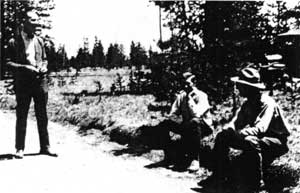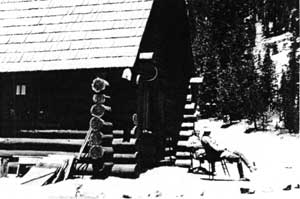Another factor which probably contributed to this movement of beetles into Munson Valley was the burning day and night, during the flight period of 1925, of slash along the new rim road which was under construction from Government Camp to the Lodge at the north end of Munson Valley. It is well known that the mountain pine beetle is readily attracted to burning slash. The map shows the relative location of all the infested areas above discussed. The red arrows are drawn on the map to show the direction of the migration of the beetles. Control areas F, H, and 1, are the only areas in direct line with this suspected drift. It seems the above evidence is sufficiently conclusive to warrant The statement that the 1926 re-infestation of the control areas F, H, and I, was caused by beetles migrating from the old-standing infestations north-east of the lake.
That there is no great hazard of such migration and consequent reinfestation of the areas south of the lake again occurring seems assured because there are not enough beetles now remaining in these old areas to make it possible. The 1925 flight represented practically the total beetle population of the region north-east of the lake.
Another budget crisis occurred in October 1926. A letter from Acting National Park Service Director Arno Cammerer to Superintendent Thomson on October 12, 1926, indicates a battle of the budgets as well as the bugs. Cammerer acknowledges a request from J.E. Patterson for an allotment of at least $2,500 to carry on a beetle project in the park in 1927 but states that there was only $500 held in reserve for 1927, and it was promised to Glacier National Park. He further said that the Park Service had requested $15,000 for insect control work in 1928, but this had been cut by the Bureau of the Budget to $7,500 and, because he understood from correspondence that the control work in Crater Lake had been “pretty well completed,” they allotted only $500 to Crater Lake. He concluded by saying, “I see no possibility of providing you with additional funds as requested for work next spring.” [12]
Patterson did not protest and probably assumed that Craighead in Washington, DC, would come through again and prevent Yellowstone from gaining all the funding.
My correspondence files are empty, unfortunately, for 1927 and 1928 so I do not know how the funding was arranged. But a control project was conducted in 1927: 2,936 lodgepole pine trees were treated at a cost of $2,500. The most remarkable thing was that the outbreak was apparently whipped, or at least stalled, because no control work was recommended for 1928. [13]
One interesting innovation occurred in the annals of beetle control work in 1927. Because of deep snow at Anna Creek, men and camps were transported success fully by tractors towing sleds. Also in 1927, the adjacent Crater National Forest treated 4,000 trees on the east edge of the park in a show of cooperation; Patterson felt there was little threat from that source in the future (see footnote 13). He did recommend that the Forest Service clean up some small infestations near Sand Creek in 1928. There was one disquieting note in the 1927 report:
Following the control work of 1927 only 545 infested trees have developed on the control areas. These trees represent the total beetle infestation at the present time. The future infestation on the control areas will depend upon the development of these 545 broods. It is not probable that they can soon increase to a point that will again menace the present stands (see footnote 13).
This seems like a risky statement given the history of the outbreak to this time.
|
|
In 1928, the Crater National Forest under Administrative Assistant Lee Brown carried out control operations on Sand Creek and north of Sand Creek between Cave Creek and the National Park boundary. [14] Apparently, neither Patterson nor anyone else from the Bureau of Entomology trained the Forest Service staff or worked with them. According to Brown’s report, the crew was trained by Forest Examiner A.J. Jaenicke who was in charge of forest insect work in the Pacific Northwest Region. Bureau of Entomology personnel were probably not involved because of the press of business in the park. Brown complained about the lack of experience of the spotters used to locate infested trees (see footnote 14). The trees were treated by the sun-curing or solar heat method advocated by Patterson, so he must have had some exchange with the Forest Service, perhaps in 1927. The Forest Service crews treated 1,257 trees at a cost of $1,000. They unfortunately ran out of funds before they completed the work. A few small groups of trees were not treated south of Sand Creek Canyon; and about 200 trees were not rolled during the solar treating, which meant that about two-thirds of the beetle brood survived and emerged. The result was that Brown recommended cleaning up the areas worked in 1927 and 1928 and estimated this would cost $1,500 in 1929 (see footnote 14).
Patterson made a fall survey in 1928 and said “…there had been a considerable infiltration of beetles from north of the Lake, as well as a build-up of the infestation locally during the year when no work was done.” [15] So the battle was not over quite yet.
***previous*** — ***next***



